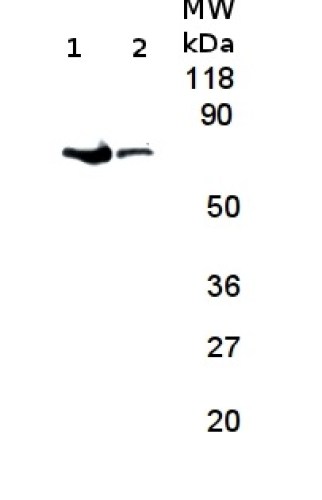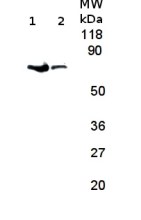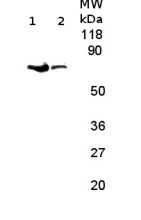
Anti-FtsH1-11 | ATP-dependent zinc metalloprotease FtsH1-11
(Cat#: AS11 1789)


Description
- Immunogen: KLH-conjugated peptide dereived from sequences of all known FtsH isoforms of Arabidopsis thaliana: FtsH1 Q39102 (At1g50250), FtsH2 O80860 (At2g30950), FtsH3 Q84WU8 (At2g29080), FtsH4 O80983 (At2g26140), FtsH5 Q9FH02 (At5g42270), FtsH6 Q1PDW5 (At5g15250), FtsH7 Q9SD67 (At3g47060), FtsH8 Q8W585 (At1g06430), FtsH9 Q9FIM2 (At5g58870), FtsH10 Q8VZI8 (At1g07510), FtsH11 Q9FGM0 (At5g53170) as well as 4 FtsH isoforms of Synechocystis sp. PCC6803NP_440330.1, NP_442160.1, NP_440797.1, NP_440525.1
- Host: Rabbit
- Clonality: Polyclonal
- Purity: Serum
- Format: Lyophilized
- Quantity: 50 µl
- Reconstitution: For reconstitution add 50 µl of sterile water
- Storage: Store lyophilized/reconstituted at -20°C; once reconstituted make aliquots to avoid repeated freeze-thaw cycles. Please remember to spin the tubes briefly prior to opening them to avoid any losses that might occur from material adhering to the cap or sides of the tube.
- Tested applications: Blue Native PAGE (BN-PAGE), Western blot (WB)
- Recommended dilutions: 1 : 500-1 : 2000 (WB)
- Expected | apparent MW: A. thaliana: FtsH1:76.7, FtsH2: 74, FtsH5: 75.2, FtsH6: 74.5, FtsH7: 87.8, FtsH8: 73, FtsH9:87.8 kDa (chloroplastic); FtsH3: 89.3, FtsH4: 77.2, FtsH10: 89.5 kDa, FtsH11:88.7 kDa (mitochondrial)
- Confirmed reactivity: Acetabularia acetabulum, Arabidopsis thaliana, Bryopsis hypnoides (ulvophytes), Guillardia theta, Hordeum vulgare, Synechocystis sp., Thalassiosira pseudonana, Thalassiosira punctigera, Zea mays
- Not reactive in: No confirmed exceptions from predicted reactivity are currently known
- FtsH belong to a family of ATP dependent peptidases. Localized in a chloroplast are following isoforms: FTSH1 (synonymes AAA, FTSH, FTSH Protease 1), Ftsh2 (VAR2, VARIEGATED 2), FtsH5 (VAR1, VARIEGATED 1), FtsH6 (FTSH PROTEASE 6), FtsH7, FtsH8. FtsH9.Localized in mitochondria are following isoforms: FtsH3 (FTSH Protease 3), FtsH4, FtsH10, FtsH11.
- Dogra et al. (2019). Oxidative post-translational modification of EXECUTER1 is required for singlet oxygen sensing in plastids. Nat Commun. 2019 Jun 27;10(1):2834. doi: 10.1038/s41467-019-10760-6. Li et al. (2016). A Hard Day's Night: Diatoms Continue Recycling Photosystem II in the Dark. Front. Mar. Sci., 08 November 2016Tietz et al. (2015). Functional Implications of Photosystem II Crystal Formation in Photosynthetic Membranes. J Biol Chem. 2015 Apr 20. pii: jbc.M114.619841.Campbell et al. (2013). Photosystem II protein clearance and FtsH function in the diatom Thalassiosira pseudonana. Photosynth. Res. March 16.
- For detection on a diatom samples, load of 5-10 µg/well is required as well as usage of enchanced chemiluminescence.The antibody also detects the chloroplast-encoded FtsH from Thalassiosira pseudonana (diatom) along with 3 related isoforms encode in the nuclear genome of Thalassiosira pseudonana.For detection in BlueNative, recommened dilution is 1: 500.
Boca Scientific is your premiere source for high-quality, innovative solutions for Cell Biology, Molecular Biology, Immunology, genetics and other lab products and reagents. We bring leading-edge products from our own-line and around the world to laboratories in the US and Canada. Our goal is to offer excellent solutions to drive research and discoveries backed by superior customer support.
